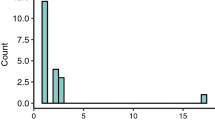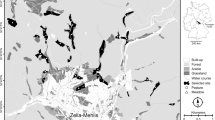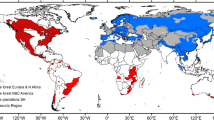Abstract
Non-native organisms have invaded novel ecosystems for centuries, yet we have only a limited understanding of why their impacts vary widely from minor to severe. Predicting the impact of non-established or newly detected species could help focus biosecurity measures on species with the highest potential to cause widespread damage. However, predictive models require an understanding of potential drivers of impact and the appropriate level at which these drivers should be evaluated. Here, we used non-native, specialist herbivorous insects of forest ecosystems to test which factors drive impact and if there were differences based on whether they used woody angiosperms or conifers as hosts. We identified convergent and divergent patterns between the two host types indicating fundamental similarities and differences in their interactions with non-native insects. Evolutionary divergence time between native and novel hosts was a significant driver of insect impact for both host types but was modulated by different factors in the two systems. Beetles in the subfamily Scolytinae posed the highest risk to woody angiosperms, and different host traits influenced impact of specialists on conifers and woody angiosperms. Tree wood density was a significant predictor of host impact for woody angiosperms with intermediate densities (0.5–0.6 mg/mm3) associated with highest risk, whereas risk of impact was highest for conifers that coupled shade tolerance with drought intolerance. These results underscore the importance of identifying the relevant levels of biological organization and ecological interactions needed to develop accurate risk models for species that may arrive in novel ecosystems.




Similar content being viewed by others
References
Akaike H (1973) Information theory and an extension of the maximum likelihood principle. In: Petrov BN, Caski F (Eds.) Proceedings of the Second International Symposium on Information Theory, pp. 267–281. Budapest
Aukema JE, McCullough DG, Von Holle B, Liebhold AM, Britton K, Frankel SJ (2010) Historical accumulation of nonindigenous forest pests in the continental United States. Bioscience 60:886–897. https://doi.org/10.1525/bio.2010.60.11.5
Blackman RL, Eastop VF (1994) Aphids on the World’s Trees: an identification and information guide. Wiley, New York, NY
Blomberg SP, Garland T, Ives AR (2003) Testing for phylogenetic signal in comparative data: behavioral traits are more labile. Evolution 57:717–745. https://doi.org/10.1111/j.0014-3820.2003.tb00285.x
Burnham KP, Anderson DR (2003) Model selection and multimodel inference: a practical information-theoretic approach, 2nd edn. Springer, Berlin, Germany
Burns RM, Honkala BH (1990) Silvics of North America: 2. Hardwoods. Washington, DC: Department of Agriculture, Forest Service
Desurmont GA, Donoghue MJ, Clement WL, Agrawal AA (2011) Evolutionary history predicts plant defense against an invasive pest. Proc Natl Acad Sci USA 108:7070–7074. https://doi.org/10.1073/pnas.1102891108
Diagne C, Leroy B, Vaissière AC, Gozlan RE, Roiz D, Jarić I, Salles JM, Bradshaw CJ, Courchamp F (2021) High and rising economic costs of biological invasions worldwide. Nature. https://doi.org/10.1038/s41586-021-03405-6
Drooz,T (1985) Insects of Eastern Forests: Miscellaneous Publication No. 1426. Washington, DC: U.S. Department of Agriculture
Fielding AH, Bell JF (1997) A review of methods for the assessment of prediction errors in conservation presence/absence models. Envir Conserv 24:38–49. https://doi.org/10.1017/S0376892997000088
Foucaud J, Hufbauer RA, Ravigne V, Olazcuaga L, Loiseau A, Ausset A, Wang S, Zang LS, Lemenager N, Tayeh A, Weyna A (2020) How do invasion syndromes evolve? An experimental evolution approach using the ladybird Harmonia axyridis. bioRxiv. https://doi.org/10.1101/849968
Furniss RL, Carolin VM (1977) Western forest insects: Miscellaneous Publication No. 1339. Washington, DC: U.S. Department of Agriculture
Fushiki T (2011) Estimation of prediction error by using K-fold cross-validation. Stat Comput 21:137–146. https://doi.org/10.1007/s11222-009-9153-8
Gandhi KJK, Herms DA (2010) Direct and indirect effects of alien insect herbivores on ecological processes and interactions in forests of eastern North America. Biol Invasions 12:389–405. https://doi.org/10.1007/s10530-009-9627-9
García Morales M, Denno BD, Miller DR, Miller GL, Ben-Dov Y, Hardy NB (2016) ScaleNet: a literature-based model of scale insect biology and systematics. http://scalenet.info.
Gianoli E, Salgado-Luarte C (2017) Tolerance to herbivory and the resource availability hypothesis. Biol Lett 13:20170120. https://doi.org/10.1098/rsbl.2017.0120
Gilbert GS, Briggs HM, Magarey R (2015) The impact of plant enemies shows a phylogenetic signal. PLoS ONE 10:e0123758. https://doi.org/10.1371/journal.pone.0123758
Grégoire JC, Raffa KF, Lindgren BS (2015) Economics and politics of bark beetles. In: Vega FE, Hofstetter RW (eds) Bark Beetles: biology and ecology of native and invasive species. Elsevier, New York, pp 585–613
Haack RA (2006) Exotic bark-and wood-boring Coleoptera in the United States: recent establishments and interceptions. Can J for Res 36(2):269–288. https://doi.org/10.1139/x05-249
Haack RA, Britton KO, Brockerhoff EG, Cavey JF, Garrett LJ, Kimberley M, Lowenstein F, Nuding A, Olson LJ, Turner J, Vasilaky KN (2014) Effectiveness of the International Phytosanitary Standard ISPM No. 15 on reducing wood borer infestation rates in wood packaging material entering the United States. PLoS ONE 9:e96611. https://doi.org/10.1371/journal.pone.0096611
Hanley JA, McNeil BJ (1982) The meaning and use of the area under a receiver operating characteristic (ROC) curve. Radiology 143:29–36. https://doi.org/10.1148/radiology.143.1.7063747
Hinchliff CE, Smith SA, Allman JF, Burleigh JG, Chaudhary R, Coghill LM, Crandall KA, Deng J, Drew BT, Gazis R, Gude K, Hibbet DS, Katz LA, Laughinghouse HD, McTavish EJ, Midford PE, Owen CL, Ree RH, Rees JA, Soltis DE, Williams T, Cranston KA (2015) Synthesis of phylogeny and taxonomy into a comprehensive tree of life. Proc Nat Acad Sci 112:12764–12769. https://doi.org/10.1073/pnas.1423041112
Huang J, Kautz M, Trowbridge AM, Hammerbacher A, Raffa KF, Adams HD, Goodsman DW, Xu C, Meddens AJH, Kandasamy D, Gershenzon J, Seidl R, Hartmann H (2019) Tree defence and bark beetles in a drying world: carbon partitioning, functioning and modeling. New Phytol 225:26–36. https://doi.org/10.1111/nph.16173
Hulcr J, Dunn RR (2011) The sudden emergence of pathogenicity in insect–fungus symbioses threatens naive forest ecosystems. Proc R Soc B 278:2866–2873. https://doi.org/10.1098/rspb.2011.1130
Jacobi WR, Koski RD, Negron JF (2013) Dutch elm disease pathogen transmission by the banded elm bark beetle Scolytus schevyrewi. For Path 43:232–237. https://doi.org/10.1111/efp.12023
Jacobs K, Bergdahl DR, Wingfield MJ, Halik S, Seifert KA, Bright DE, Wingfield BD (2004) Leptographium wingfieldii introduced into North America and found associated with exotic Tomicus piniperda and native bark beetles. Mycol Res 108:411–418
Johnson WT, Lyon HH (1991) Insects that feed on trees and shrubs. Comstock Publishing/Cornell University Press, Ithaca, NY
Keck F, Rimet F, Bouchez A, Franc A (2016) Phylosignal: An R package to measure, test, and explore the phylogenetic signal. Ecol Evol 6:2774–2780. https://doi.org/10.1002/ece3.2051
Kenis M, Roques A, Santini A, Liebhold AM (2017) Impact of non-native invertebrates and pathogens on market forest tree resources. In: Vilà M, Hulme PE (Eds.) Impact of Biological Invasions on Ecosystem Services, pp. 103–117. Invading Nature - Springer Series in Invasion Ecology 12. Springer International Publishing. https://doi.org/10.1007/978-3-319-45121-3_7
Kirkendall LR, Biedermann PH, Jordal BH (2015) Evolution and diversity of bark and ambrosia beetles. In: Vega FE, Hofstetter RW (eds) Bark Beetles: biology and ecology of native and invasive species. Elsevier, New York, pp 85–156
Kumar S, Stecher G, Suleski M, Hedges SB (2017) TimeTree: a resource for timelines, timetrees, and divergence times. Mol Biol Evol 34:1812–1819. https://doi.org/10.1093/molbev/msx116
Larjavaara M, Muller-Landau HC (2010) Rethinking the value of high wood density. Funct Ecol 24:701–705. https://doi.org/10.1111/j.1365-2435.2010.01698.x
Lee JC, Seybold SJ (2010) Host acceptance and larval competition in the banded and European elm bark beetles, Scolytus schevyrewi and S. multistriatus (Coleoptera: Scolytidae): potential mechanisms for competitive displacement between invasive species. J Insect Behav 23:19–34. https://doi.org/10.1007/s10905-009-9192-1
Liebhold AM, Brockerhoff EG, Kalisz S, Nuñez MA, Wardle DA, Wingfield MJ (2017) Biological invasions in forest ecosystems. Biol Invasions 19:3437–3458. https://doi.org/10.1007/s10530-017-1458-5
Loehle C (1988) Tree life history strategies: the role of defenses. Can J for Res 18:209–222. https://doi.org/10.1139/x88-032
Lovett GM, Weiss M, Liebhold AM, Holmes TP, Leung B, Lambert KF, Orwig DA, Campbell FT, Rosenthal J, McCullough DG, Wildova R, Ayres MP, Canham CD, Foster DR, LaDeau SL, Weldy T (2016) Nonnative forest insects and pathogens in the United States: impacts and policy options. Ecol Appl 26:1437–1455. https://doi.org/10.1890/15-1176
Mazerolle MJ (2019) AICcmodavg: Model selection and multimodel inference based on (Q)AIC(c). R package version 2.2‐2. Retrieved from https://CRAN.R-project.org/package=AICcmodavg
Mech AM, Thomas KA, Marsico TD, Herms DA, Allen CR, Ayres MP, Gandhi KJ, Gurevitch J, Havill NP, Hufbauer RA, Liebhold AM, Raffa KF, Schulz AN, Uden DR, Tobin PC (2019) Evolutionary history predicts high-impact invasions by herbivorous insects. Ecol Evol 9:12216–12230. https://doi.org/10.1002/ece3.5709
Mech AM, Thomas KA, Havill NP, Schulz AN, Tobin PC (2020a) Traits and Factors Catalog (TRAFAC): Conifer specialists of North America: U.S. Geological Survey data release, https://doi.org/10.5066/P9CLFQMI
Mech AM, Hoover AM, Schulz AN, Barnes B, Boyd K, Durden L, Havill NP, Hufbauer R, Liebhold AM, Marsico TD, Raffa K, Singareddy C, Teach E, Tobin PC, Wolf A, Thomas KA (2020b) Traits and Factors Catalog (TRAFAC): Hardwood specialists of North America: U.S. Geological Survey data release. https://doi.org/10.5066/P9FT7C1O
Miles PD, Smith WB (2009) Specific gravity and other properties of wood and bark for 156 tree species found in North America. U.S. Department of Agriculture Research Note NRS‐38. Newtown Square, PA. https://doi.org/10.2737/NRS-RN-38
Morris H, Hietala AM, Jansen S, Ribera J, Rosner S, Salmeia KA, Schwarze FW (2020) Using the CODIT model to explain secondary metabolites of xylem in defence systems of temperate trees against decay fungi. Annals Bot 125:701–720. https://doi.org/10.1093/aob/mcz138
Nagelkerke N (1991) A note on a general definition of the coefficient of determination. Biometrika 78:691–692. https://doi.org/10.1093/biomet/78.3.691
Nakazawa M (2019) fmsb: Functions for Medical Statistics Book with some Demographic Data. R package version 0.7.0. https://CRAN.R-project.org/package=fmsb
Neely D (1988) Wound closure rates on trees. J Arboriculture 14:250–254
Ohmart CP (1989) Why are there so few tree-killing bark beetles associated with angiosperms? Oikos 54:242–245. https://doi.org/10.2307/3565273
Pearce RB (1996) Antimicrobial defences in the wood of living trees. New Phytol 132:203–233. https://doi.org/10.1111/j.1469-8137.1996.tb01842.x
Pickering J (2011). Discover Life. Retrieved from http://www.discoverlife.org
Pyšek P, Jarošík V, Hulme PE, Pergl J, Hejda M, Schaffner U, Vilà M (2012) A global assessment of invasive plant impacts on resident species, communities and ecosystems: the interaction of impact measures, invading species’ traits and environment. Glob Change Biol 18(5):1725–1737. https://doi.org/10.1111/j.1365-2486.2011.02636.x
R Core Team (2020) R: A language and environment for statistical computing. R Foundation for Statistical Computing, Vienna, Austria. https://www.R-project.org/
Raffa KF, Grégoire JC, Lindgren BS (2015) Natural history and ecology of bark beetles. In: Vega FE, Hofstetter RW (eds) Bark Beetles: biology and ecology of native and invasive species. Elsevier, New York, NY, pp 1–40
Ramsfield TD (2016) Evolving symbioses between insects and fungi that kill trees in Canada: new threats associated with invasive organisms. Can Entomol 148:S160–S169. https://doi.org/10.4039/tce.2015.65
Revell LJ (2012) Phytools: an R package for phylogenetic comparative biology (and other things). Methods Ecol Evol 3:217–223
Ricciardi A, Hoopes MF, Marchetti MP, Lockwood JL (2013) Progress toward understanding the ecological impacts of nonnative species. Ecol Monogr 83(3):263–282. https://doi.org/10.1890/13-0183.1
Robinson GS, Ackery PR, Kitching IJ, Baccaloni GW, Hernández LM (2010). HOSTS – a database of the world's Lepidopteran hostplants. London, UK: Natural History Museum. Retrieved from http://www.nhm.ac.uk/hosts
Schulz AN, Mech AM, Allen CR, Ayres MP, Gandhi KJK, Gurevitch J, Havill NP, Herms DA, Hufbauer RA, Liebhold AM, Raffa KF, Raupp MJ, Thomas KA, Tobin PC, Marsico TD (2020) The impact is in the details: evaluating a standardized protocol and scale for determining non-native insect impact. NeoBiota 55:61–83. https://doi.org/10.3897/neobiota.55.38981
Simberloff D, Martin JL, Genovesi P, Maris V, Wardle DA, Aronson J, Courchamp F, Galil B, García-Berthou E, Pascal M, Pyšek P, Sousa R, Tabacchi E, Vilà M (2013) Impacts of biological invasions: what’s what and the way forward. Trends Ecol Evol 28:58–66. https://doi.org/10.1016/j.tree.2012.07.013
Smith SA, Brown JW (2018) Constructing a broadly inclusive seed plant phylogeny. Am J Bot 105:302–314. https://doi.org/10.1002/ajb2.1019
Smith SM, Hulcr J (2015) Scolytus and other economically important bark and ambrosia beetles. In: Vega FE, Hofstetter RW (eds) Bark Beetles: biology and ecology of native and invasive species. Elsevier, New York, pp 495–531
Smith A, Herms DA, Long RP, Gandhi KJ (2015) Community composition and structure had no effect on forest susceptibility to invasion by the emerald ash borer (Coleoptera: Buprestidae). Can Entomol 147:318–328. https://doi.org/10.4039/tce.2015.8
Sperry JS, Hacke UG, Pittermann J (2006) Size and function in conifer tracheids and angiosperm vessels. Am J Bot 93:1490–1500. https://doi.org/10.3732/ajb.93.10.1490
Tobin PC, Kean JM, Suckling DM, McCullough DG, Herms DA, Stringer LD (2014) Determinants of successful arthropod eradication programs. Biol Invasions 16:401–414. https://doi.org/10.1007/s10530-013-0529-5
United States Department of Agriculture-Natural Resources Conservation Services (2016) The PLANTS Database. National Plant Data Team. Greensboro, NC. Retrieved from http://plants.usda.gov
Wingfield MJ, Slippers B, Wingfield BD (2010) Novel associations between pathogens, insects, and tree species threaten world forests. NZ J for Sci 40:95–103
Wingfield MJ, Garnas JR, Hajek A, Hurley BP, de Beer ZW, Taerum SJ (2016) Novel and co-evolved associations between insects and microorganisms as drivers of forest pestilence. Biol Invasions 18:1045–1056. https://doi.org/10.1007/s10530-016-1084-7
Yamanaka T, Morimoto N, Nishida GM, Kiritani K, Moriya S, Liebhold AM (2015) Comparison of insect invasions in North America, Japan, and their Islands. Biol Invasions 17:3049–3061. https://doi.org/10.1007/s10530-015-0935-y
Yan Z, Sun J, Don O, Zhang Z (2005) The red turpentine beetle, Dendroctonus valens LeConte (Scolytidae): an exotic invasive pest of pine in China. Biodivers Conserv 14:1735–1760. https://doi.org/10.1007/s10531-004-0697-9
Acknowledgements
We thank Dr. Jill Baron and the U.S. Geological Survey John Wesley Powell Center for Analysis and Synthesis, Fort Collins, CO, for their support of this project. We also thank David Campbell (University of Washington) and Terry Arundel (USGS) for database assistance, Karla Boyd (University of Maine), Lekeah Durden (USGS-NFS Graduate Research Intern), and Atticus Wolf (University of Arizona) for assistance with data entry, and Dr. Gary Lovett for feedback on an early draft of the manuscript.
Funding
This project was conducted as a part of the “Predicting the next high-impact insect invasion: Elucidating traits and factors determining the risk of introduced herbivorous insects on North American native plants” working group supported by the U.S. Geological Survey John Wesley Powell Center for Analysis and Synthesis (to KAT, TDM, DAH, and PCT, and Cooperative Agreement No. G16AC00065 to PCT) and the U.S. Department of Agriculture Forest Service Eastern Forest Environmental Threat Assessment (Grant No. 15‐JV‐11242303‐103 to PCT). Additional support was provided by the University of Washington, Nebraska Cooperative Fish and Wildlife Research Unit, U.S. Department of Agriculture Forest Service National Urban and Community Forestry Advisory Council Grant (Grant No. 19-DG-11132544-022 to RAH, DAH, and MPA), National Science Foundation Long Term Ecological Research program (MPA), U.S. Department of Agriculture Forest Service International Programs (MPA and AML), U.S. Department of Agriculture National Institute of Food and Agriculture (Hatch project 1012868 to RAH and Hatch project ME022124 to AMM through the Maine Agricultural & Forest Experiment Station), and U.S. Geological Survey Ecosystems Mission Area to KAT and AMH. PCT acknowledges support from the David R.M. Scott Endowed Professorship in Forest Resources. Salary support and matching funds were provided by our respective institutions. Any use of trade, firm, or product names is for descriptive purposes only and does not imply endorsement by the United States Government.
Author information
Authors and Affiliations
Contributions
TDM, KAT, DAH, and PCT conceived the project. All authors contributed to the study design; AMM, AMH, NPH, ANS, TDM, KAT, RAH, and AML collected the study data; ANS, AMM, DRU, and NPH analyzed the data; all authors contributed to writing and editing the manuscript; all authors gave final approval for publication and agree to be held accountable for the work performed therein.
Corresponding author
Ethics declarations
Conflict of interest
We declare we have no competing interests.
Additional information
Publisher's Note
Springer Nature remains neutral with regard to jurisdictional claims in published maps and institutional affiliations.
Supplementary Information
Below is the link to the electronic supplementary material.
Rights and permissions
About this article
Cite this article
Schulz, A.N., Mech, A.M., Ayres, M.P. et al. Predicting non-native insect impact: focusing on the trees to see the forest. Biol Invasions 23, 3921–3936 (2021). https://doi.org/10.1007/s10530-021-02621-5
Received:
Accepted:
Published:
Issue Date:
DOI: https://doi.org/10.1007/s10530-021-02621-5




